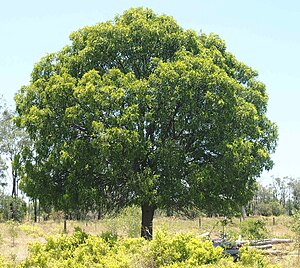Owenia acidula
| Owenia acidula | ||||||||||||
|---|---|---|---|---|---|---|---|---|---|---|---|---|

Owenia acidula |
||||||||||||
| Systematics | ||||||||||||
|
||||||||||||
| Scientific name | ||||||||||||
| Owenia acidula | ||||||||||||
| F. Garbage. |
Owenia acidula is a species of mahogany family from northern to eastern and all of western Australia . Here it is known as Emu apple , Colane , Gruie , or Sour plum .
description
Owenia acidula grows as a deciduous shrub up to 3 meters high or as a tree with a short trunk and hanging branches up to 8-10 meters high. The trunk diameter reaches 25-30 centimeters. The thick, brown-grayish bark is furrowed. The tree has a milky sap . The flower buds and young shoots are resinous.
The alternate and stalked leaves at the branch ends are usually pinnate in pairs with up to 34 leathery leaflets . The rachis is often slightly winged. The leaf stalk is up to 7.5-15 inches long. The almost sessile, narrow, eilanzettlich or lanceolate and entire, rounded to round-pointed or pointed to prickly-pointed, bald leaflets are up to 5 centimeters long and 8-14 millimeters wide. The leaf blade is often uneven, the veins are pinnate with indistinct lateral veins.
Owenia acidula is dioecious dioecious . Axillary, about 10-12 centimeters long thyrses are formed. The cream-colored to brownish, small and almost sessile, functionally unisexual flowers are five-fold with a double flower envelope . The small, almost rounded and dome-shaped, free sepals are about 2 millimeters long. The 5 upright, elongated and free petals are roof-top and up to 4–5 millimeters long. The 10 short stamens are fused together in a tube with fine fringes at the top, the seated anthers are attached inside, slightly below, between the teeth. The multi-chambered ovary is upper constant with a short and chubby stylus with conical scar . There is a thin disc . There are pestillodes (sterile pistils) in the male flowers and staminodes (sterile stamens) in the female flowers.
There are small, reddish, often whitish spotted, slightly rough, apple-like and round, mehrsamige, to 3.5 centimeters drupes formed with some recessed stylus remains at the top. The very hard and thick-shelled stone core is multicellular. The egg-shaped seeds have a thin sarcotesta . They are difficult to germinate , it is said that they only germinate after an emu has digested them, hence the common name emu apple .
The number of chromosomes is 2n = 28.
use
The quite sour fruits are edible. They are used raw or cooked.
The red-brown, beautiful and quite hard wood is rarely used, but it is well suited for turning .
literature
- JH Maiden : The Forest Flora of New South Wales. Vol. II, Part. 4, XIV, Gullick, 1904 (1907), pp. 89 ff, Pl. 53, online at biodiversitylibrary.org.
- Flora of Australia. Volume 26, CSIRO, 2013, ISBN 978-0-643-10955-1 , pp. 1 ff, 15, 17, online (PDF; 35 MB).
- Michel Baumer: Notes on Trees and Shrubs in Arid and Semi-arid Regions. Emashar Phase II, FAO, 1983, ISBN 92-5-101354-3 , p. 212 f.
- K. Kubitzki : The Families and Genera of Vascular Plants. Vol. X: Flowering Plants Eudicots Springer, 2011, ISBN 978-3-642-14396-0 , pp. 185 ff, 189, 204.
- Gwen J. Harden: Flora of New South Wales. Rev. Edition, Volume 2, UNSW Press, 2002, ISBN 0-86840-609-0 , p. 328 f.
Web links
- Owenia acidula at Useful Tropical Plants.
- Owenia at FloraBase - the Western Australian Flora.
